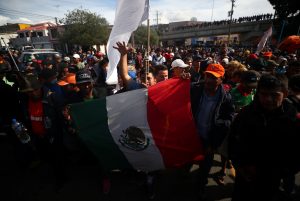
By Lizbeth Diaz
TIJUANA (Reuters) – Hundreds of Central American migrants in Mexico massed on Thursday around a tense U.S. border crossing, where security measures held up long lines of Mexicans headed to Thanksgiving gatherings on the other side of the frontier.
With few belongings and many of them with children in tow, the migrants set out for the crossing from the baseball field in the Mexican border city of Tijuana where they have been camped out. Around 6,000 migrants who have trekked across Mexico in a caravan in recent weeks are now crammed into the field.
They arrived at the Chaparral border crossing, opposite San Diego, California, and said they would wait there until they could request asylum, in spite of growing U.S. measures to tighten the border.
“We are already desperate, last night it rained and we all got wet. There is no room left. We are all sick. My children have a cold … and nobody has come to give us help,” said David, a Honduran who only provided his first name.
Earlier on Thursday, U.S. President Donald Trump said he had authorized the use of lethal force on the border and warned that the United States could close the whole frontier.
The San Ysidro vehicular crossing into San Diego, one of the busiest in the world, was briefly shuttered in the afternoon by U.S. officials as they performed a security exercise.
Tens of thousands of Mexicans enter the United States daily to work or study, and many were trying to get to Thanksgiving celebrations. Mariana del Campo, a retired professor, had hoped to make it across before the closing but was stuck in the line.
“What’s happening on the border is maddening,” she said as she waited in her car. “I don’t know how long we can put up with this. Someone is going to get tired or explode.”
Also stuck in her car waiting to cross for Thanksgiving was 54-year-old Aurora Diaz, who said her U.S.-based daughter was reluctant to visit Mexico in case Trump closed the border.

Migrants, part of a caravan of thousands from Central America trying to reach the United States, make their way to the El Chaparral port of entry border crossing between Mexico and the United States, in Tijuana, Mexico, November 22, 2018. REUTERS/Hannah McKay
U.S. OR BUST
Tensions were palpable at the pedestrian crossing where the Central Americans had gathered. Mexican police and soldiers stood guard while a helicopter buzzed over the U.S side.
Edgar Corzo, an official from Mexico’s human rights commission, spoke into a megaphone to the crowd, telling them they could request assistance in Mexico.
But migrants arrived with blankets and prepared to bed down for the night outside the border station. Some of the children cried and complained of the cold.
Authorities in Tijuana said the migrants are facing up to a six-month wait to be able to get an appointment to plead their case for asylum with U.S. authorities.
Earlier this week, U.S. officials briefly closed the main border crossing in Tijuana, putting up concrete barricades and razor wire after reports that migrants could try to rush the crossing.
“I want President Trump to know that we’re peaceful people, we don’t have weapons, we haven’t come to do evil,” said a man who declined to give his name, holding a white flag on a wooden stick that read “Peace, God is with us.” “We want to work, we want them to help us for the love of God,” he added.
(Reporting by Lizbeth Diaz, Writing by Michael O’Boyle, Editing by Rosalba O’Brien)
